Top News
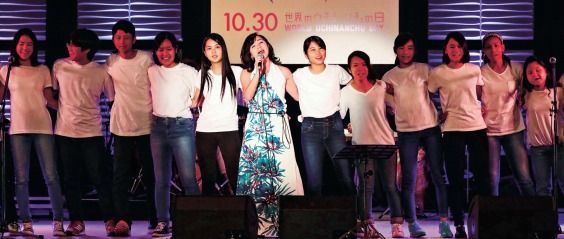
October 31, 2017 Ryukyu Shimpo
Okinawa Prefecture hosted “World Uchinanchu Day,” which was designated last year the 6th International Uchinanchu Festival, on October 30 at the ANA Crown Plaza Hotel Okinawa Harbor View in Naha.
The event was attended by 230 people from Okinawa Prefecture and its towns in addition to people from the business community and various cultural figures.
Both Okinawan and Okinawan descendants abroad who attended formed closer bonds, committing themselves to Okinawan pride, culture, and unity.
At the first-ever celebration of its kind, Okinawan folk singers Sadao China, Hajime Nakasone, and Vanesa Oshiro performed music backed up by fellow Uchinanchu from all over.
Singers Kazufumi Myazawa and Alberto Shiroma (from the band Diamantes) teamed up with the performance group Requios for an Eisa dance, accompanies by the enthusiastic clapping of attendees.
The hall in Naha was connected by video and sound to the Brazilian Okinawan People’s Association, who took part in the celebration remotely.
Governor Takeshi Onaga said, “I hope that the World Uchinanchu Day will continue to broaden and strengthen the global Uchinanchu network.”
Former Okinawa Television newscaster Shinichi Maebara, whose coverage has spanned around 500 Okinawans from 35 countries, touched upon the fact that there were a large number of Okinawans all over the world who inherit traditional art and spirit, saying, “I hope that the World Uchinanchu Day will actually serve as a day for us to think about what the Uchina spirit is.”
Finally, the second-generation Argentinian born singer Claudia Oshiro performed the song used in the World Uchinanchu Day commercial, “Mirai Kanae.”
Oshiro locked arms with foreign-born youth who participated in the “Uchina Junior Study,” where they learn about Okinawan history and culture, singing with passion.
(English translation by T&CT and Sam Grieb)
Go to Japanese
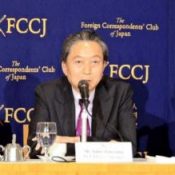
October 28, 2017 Ryukyu Shimpo
On October 26, Former Prime Minister and East Asian Community Institute (EACI) Chairman Yukio Hatoyama, Ryukoku University Professor Yasukatsu Matsushima from the Association of Comprehensive Studies for Independence of the Lew Chewans (ACSILs), and Kagoshima University Professor Akira Kimura from the East Asian Community Okinawa held a press conference at the Foreign Correspondents’ Club of Japan in Tokyo.
They criticized the construction of the helipads in the Northern Training Area (NTA) and forcing through with the construction of the new Henoko base. Hatoyama emphasized that “Decreasing the number of U.S. military bases starting with Okinawa will be important in getting rid of North Korea’s intention of attacking Japan.”
Hatoyama criticized the government’s response regarding North Korea. He said, “It’s a mistake to say that the era for dialogue is over.
Extending sanctions will only lead to war.
It’s because of such thoughts that lead to ideas like constructing new U.S. military bases in Henoko and Takae or strengthening our Self-Defense Forces.
” He then asserted that “China too intends to flex their muscle to threaten us. All we have to do is to get rid of that intention.”
He proposed to decrease the number of U.S. military bases across Japan starting with Okinawa.
He also expressed his opinion that by forming the East Asia Community, Japan would be able to avoid military conflict.
Matsushima rolled out his independence theory.
He said, “Okinawa continues to be a colony.
Militarization of the bases continue and it’s transmitting a message that says, ‘the U.S. and Japan don’t mind going to war.
’ We are focusing on trying to escape from that.”
Kimura presented the activities of the East Asian Community Okinawa that was established last September.
He pointed out the importance of Okinawa exercising its right to self-determination.
(English translation by T&CT and Chelsea Ashimine)
Go to Japanese

October 27, 2017 Ryukyu Shimpo
Twelve children between the age of four and eleven living in Fukushima prefecture and their six mothers were invited to the Geruma Camp at Geruma Island, Zamami Village in Okinawa on October 24 and 25.
The event has been carried out annually to support the people affected by the Fukushima Daiichi Nuclear crisis and the Great East Japan Earthquake.
The project was launched by Okinawan model, Kurara Chibana, in 2012. The participants enjoyed looking at the bottom of the beach and picking up shells.
One child tasted the sea water saying “I didn’t know the ocean tasted salty.” The children enjoyed the beach.
The Geruma Camp was started around Fall in 2011 after Chibana heard about mothers’ stories in Fukushima.
She learned about the concern of parents who could not allow their children to play around soil and water because they were worried about radiation contamination from the accident. Chibana then launched the project, saying, “I want to support the mothers who are trying to help their children.
Although it’s only for a short time, I want them to enjoy the nature in Okinawa as much as possible.” This year marks the sixth year of the event, and many of the children who visited Geruma island swam in the water for the first time after the disaster.
Ami, a five-years old daughter of Rie Naito from Iwaki City experienced the ocean for the first time.
The fourty-two year old mother had mixed feeling as she watched her daugter Ami jumping into the water.
She felt a sadness when her daughter said, ‘the sea tastes salty’. “I realized that she didn’t even know how sea water tasted”, she said.
A thirty-seven year old mother Toshie Tejima gave birth to her daughter four years ago at a clinic only seven kilometers away from the Fukushima Daiichi Nuclear Power Station.
They still live in temporary housing. Tejima said as she observed her daughter calmly, “every single day we worry about food.
The issues have not been solved, but we were releaved a little bit while we were in Okinawa. My daughter was smiling the whole time.”
Chibana says; “the concerns among mothers have gotten stronger over the past six years.
There are still many mothers who struggle and feel concerned about radioactive contamination.
Some people are not even able to raise their voice because they feel it would interrupt the recovery effort. I would like to continue the camp until people feel fully safe.”
(English translation by T&CT and Sayaka Sakuma)
Go to Japanese

October 20, 2017 Ryukyu Shimpo
A female lion named Ringo, who was raised at the Okinawa Zoo & Museum, died at 10:40am on October 16.
She died of natural causes at the age of 18 and two months. In general, lions in captivity usually live for about 15 years.
The zoo said, “she lived her life fully.
” Ringo was sent from Kyushu Nature Animal Park African Safari in Oita prefecture in November 2004.
Since then, she has been included in various events at the zoo.
According to the zoo, Ringo had a strong personality and would dominate a male lion when they were put together.
At the same time she also showed her sensitive character as she developed a stomach issue called acute gastroenteritis when the male lion died.
She has had an issue with her left front leg from last year, and the zoo had been treating the inflammation.
The zoo reflected that “she was loved by many people. Thank you for your warm encouragement.”
(English translation by T&CT and Sayaka Sakuma)
Go to Japanese
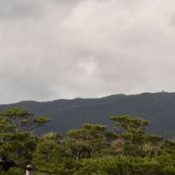
October 17, 2017 Ryukyu Shimpo
On October 26, the Ministry of Defense confirmed it will resume U.S. military aircraft flights and presented an opinion on the recent accident involving a U.S. military helicopter making a crash landing and catching fire in Takae, Higashi Village.
The Ministry of Defense provided the following comment regarding the cause of the accident; “The U.S. military seems to have taken certain measures to ensure the safety of the pilots.
” On the same day, the Ministry of Defense provided a summary of the accident and explanation of the initial investigation received from the U.S. military.
As residents remain concerned, criticism of the government for approving the response of the U.S. military is likely to increase.
While the reasons for the fire that caused the forced landing remain unknown, the U.S. military said, “We could not find materials in the initial survey that would determine a fire caused by a structural defect of the airframe.
” They described the accident as a “unique” case.
The U.S. military survey concluded after comprehensively taking into consideration opinions of experts such as the First Marine Air Defense Corps, the U.S. Navy Safety Center and the Sikorsky manufacturing company.
The military suspended flights of the same aircraft for 12 to 17 days and conducted inspections of the same type of aircraft deployed in the prefecture.
They also conducted re-training on safe flight for crew members and maintenance personnel.
The Japanese self-defense officials questioned the U.S. military about the aircraft until the 20th and the Ministry of Defense evaluated the response by the U.S. military.
The Ministry of Defense concluded, “It was completely controlled”, after listening to the US military’s report on the damage to the propeller.
The inspection report stated, “there are no problems with any aircrafts other than the aircraft involved in the accident.
” The Ministry resumed flights after it was satisfied the military would take measures to prevent a recurrence.
(English translation by T&CT and Megumi Chibana)
Go to Japanese
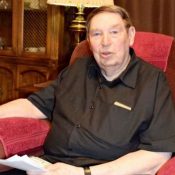
October 26, 2017 Ryukyu Shimpo
Washington Special Correspondent Yukiyo Zaha reporting
On June 19, 1959, a Nike Hercules surface-to-air missile equipped with a nuclear warhead at US-controlled Naha Air Base was accidentally ignited and fired due to a maintenance error, and ended up submerged in the ocean.
A former U.S. Army Nike Hercules missile maintenance man who was at Naha Air Base during the incident, now 81-year-old Robert Roepke of Wisconsin, provided his account in an interview with Ryukyu Shimpo.
Roepke said that just before the missile was fired a blue-alert had come down.
This meant the battery was preparing for potential missile launch due to a perceived threat.
The Nike Hercules battery to which Roepke belonged recognized that even after the incident occurred, another missile, this one equipped with high explosives, was being made ready for launch.
Roepke first made details of this accident public this September during the broadcast of an NHK special titled Okinawa and U.S. Nuclear Weapons (Okinawa to Kaku).
According to Roepke, the accidentally fired missile contained a warhead similar in size and yield to the atomic bomb dropped on Hiroshima.
While the missile equipped with high explosives was topside, a stand down order came through the chain of command.
One soldier was immediately killed due to the accidental firing, and another died a week later.
The National Personnel Records Center (NPRC) of the National Archives at St. Louis, Missouri, has the Nike Hercules battery’s daily reports for safekeeping.
On June 19 that year, the report recorded the cause of the soldier’s death as “ignition of a Nike Hercules missile.
” This accident could have resulted in a catastrophe, but the U.S. military announced no detail of the incident and had the missile recovered from the ocean in secret.
The battery’s daily records on the next day and onward note duties being executed as usual.
At that time Roepke was in charge of missile assembly and maintenance.
He said that after the incident the battery received communiqué from incident investigative teams belonging to organs like the Department of Defense and the Central Intelligence Agency.
However, the incident was kept secret, and those involved were forbidden to disclose anything about the accident.
During the Cold War, U.S.-occupied Okinawa bore a large quantity of U.S. nuclear weaponry.
This lasted between the mid-1950s and 1972, when Okinawa was returned to Japanese sovereignty.
The Department of Defense announced for the first time in 2015 that the U.S. had possessed nuclear weaponry in pre-return Okinawa.
Former U.S. soldier details account of 1959 Naha accidental nuke firing fatal to fellow soldiers
(English translation by T&CT and Erin Jones)
Go to Japanese
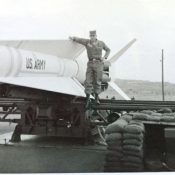
October 26, 2017 Ryukyu Shimpo
Washington Special Correspondent Yukio Zaha reporting
Fifty-eight years ago on June 19, a sunny Friday morning, a Nike Hercules surface-to-air missile equipped with a nuclear warhead was fired accidentially from U.S.-controlled Naha Air Base.
While under a blue-alert, meaning missiles were being prepared in response to a perceived threat, the booster of the missile in question was ignited by mistake due to a soldier’s blunder on a connection of the ignition system.
With a resounding roar the missile fired, and hurtled along the surface of the ocean at an incredible speed before submerging.
Left in its wake were broken and bloodied soldiers and missile fragments.
Robert Roepke, an 81-year-old former U.S. Army serviceman who worked in missile maintenance, provided his account of this disaster that happened on Naha Air Base in 1959, formerly unbeknownst to Okinawans.
According to Roepke, the Nike base in Naha had two missile launch pads facing the East China Sea.
Generally, there were just four missiles at the ready on these pads.
Fences, retaining walls, and hills surrounded the launch pads.
Roepke said he does not think people could see inside from any outside spot.
Roepke said that on the day of the incident, when he used a measuring instrument to check the connection of the ignition system, the device made a small sound indicating an abnormality.
“I don’t think we should plug it in,” he said to another soldier before he crossed the launch pad and started down a staircase to check on another machine.
In that instant, an ear-splitting roar reverberated and a blue flash like fireworks split the air overhead.
As Roepke looked in the direction of the ocean, and saw the missile drop into the water.
The soldier to whom Roepke had spoken was blown away by the launch and lay torn in half near the launch pad.
Roepke remembered: “I looked at him and his mouth was kind of going like he wanted to say something to me.
Basically, he was dead already.
” Another soldier burned by the fire from the missile’s booster was blown into the fence.
He was administered first aid while another missile equipped with high explosives was being moved and prepared for launch.
Then the stand down order came through the chain of command.
Roepke said: “As far as I know I might be the only one involved who is still living.
I would be glad to talk about it now that we’re free, because I would like to get my stuff on record.”
When asked if he wanted to convey anything to Okinawans he said: “The missiles were for defense and not aggression.
We were there to protect the people of Okinawa as well as our own interests.”
(English translation by T&CT and Erin Jones)
Former U.S. missile maintenance man gives interview on 1959 Naha accidental missile firing
Go to Japanese
October 25, 2017 Ryukyu Shimpo
On October 24, the University of the Ryukyus (President: Hajime Oshiro) announced its “Basic Policy Regarding Military Security Research,” which sets forth the university’s stance that it will not engage in research with the direct purpose of military use or research funded by public entities with jurisdiction over the military in Japan or abroad.
The policy also states that privately-funded research and “dual-use” research that is difficult to classify because it is also used for civilian purposes will undergo review within the university if there is a chance that it could be used for military purposes.
Rules for such reviews and the makeup of the review committee will be discussed going forward and decided by the end of this school year.
According to the university, it will be a forerunner nationwide in terms of setting up review rules and a review committee for this sort of research.
In August 2015, the University of the Ryukyus announced President Oshiro’s view that the university “should refrain” from engaging in research supported by the Ministry of Defense’s new National Security Technology Research Promotion Fund, for which the ministry had recently started accepting applications.
In practice, the university banned application to the Ministry of Defense funding from that point in time.
In March of this year, the Science Council of Japan published a statement announcing that it will not engage in military research and called on universities in Japan to institute a system to review the suitability of research deemed to be military security research.
The University of the Ryukyus heeded this call and had an internal working group consider the matter.
On October 11, after receiving the working group’s final report, the board of directors made its final decision upon listening to opinions from the Education and Research Council comprising the deans of each school and all faculty at the university.
(English translation by T&CT and Sandi Aritza)
Go to Japanese
October 25, 2017 Ryukyu Shimpo
By Ikue Nakaima
It was discovered on October 24 that there exists an active fault line in the undersea section of the construction zone for the Henoko Base in Nago.
In the “Map of the undersea section” figure, part of the data collected by the “Alternative Facilities Construction Committee” formed by the Ministry of Defense in 2000, there is a depression on the map in an area close to 50 meters in length.
Dr. Yuzo Kato, professor emeritus at the University of the Ryukyus (specializing in petrology), said, “If the depression was formed in a relatively recent era, there is a chance that the seafloor fault line can grow larger.”
Already, on the island portion of the area plotted out for the new base, there is the “Henoko Fault,” and the “Sukku Fault.”
The continuation of these faults extend to a steep valley and incline on the seafloor.
Furthermore, the depression disclosed by the Ministry of Defense is overlapping. The fault appears to show evidence of earthquakes in the past, meaning that as an active fault there is a good probability of earthquakes in the future, casting doubt on the suitability of the location for a military base.
October 25 is also the six-month anniversary of the start of seawall construction.
According to Ministry of Defense data, the band of seafloor that stretches from Nagashima to the Chuhi reef known as the “Ryukyu Group” contains a depression of over 50 meters.
The Ministry of Defense also writes that “the depression can be thought to come from a fault at its base,” although it gives no indication for when the fault could become active.
In response to Ryukyu Shimpo’s October 24 coverage of the existence of an active fault in the construction zone, the Okinawa Defense Bureau (ODB) commented that, “Depending on the source, an obvious active fault in the Northern Area cannot be confirmed or denied.
” With regards to the safety of the seafloor in the construction zone, the ODB responded that they, “are still investigating, and cannot definitively say at this time.”
The Ryukyu Group where this 50-meter depression was found is a band of earth that contains Ryukyu Limestone, and was formed no earlier than a few hundred thousand years prior.
Prof. Kato commented, “Since this band of earth has formed over a more recent era, there is a chance that it could see movement hereafter, which leads to the possibility of an active fault as well.”
The two land-based faults, (Henoko and Sukku) are classified as active in the document, “Nago, Yanbaru Geology,” published by the Nago City Department of Education. An active classification means that the faults have experienced movement no later than a few hundred thousand years prior, to which Prof.
Kato also says means that “These two faults as well could become active.”
From February through April the ODB conducted a geological survey over the undersea section of the construction zone on the large-scale multipurpose vessel Poseidon, although the results have not been released.
Prof. Kato also mentioned that, “In order to refute the possibility of an active fault Japan needs to release and present the supporting data immediately.
” He also noted that the undersea construction zone contained much of the soft, cavity-filled Ryukyu Limestone.
Prof. Kato noted the danger of this as well, stating, “Even if the base is carefully constructed, if the fault directly below were to experience movement, the facilities would be destroyed.”
(English translation by T&CT and Sam Grieb)
Go to Japanese
October 25, 2017 Ryukyu Shimpo
On October 24, the 18th Wing at U.S. Kadena Air Base announced that it will deploy at least 12 F-35A stealth fighters to the base in November for half a year.
According to local municipalities, two aircraft are scheduled to arrive this week. It will be the first deployment in the India, Asia and the Pacific region.
The U.S. Air Force emphasized the importance of providing global and accurate attack capability against increasing threats.
The local municipalities are opposed to the F-35A deployment because it will increase the base burden on local people.
They have sent a protest letter to the U.S. military.
On October 24, the Three Municipalities Liaison Council (Chairperson Okinawa City Mayor Sachio Kuwae) consisting of the mayors of Okinawa City, Kadena and Chatan Town near the Kadena Air Base sent a protest letter to the relevant agencies of the U.S. and Japanese governments urging them to stop the F-35A deployment.
The protest letter was sent to the 18th Wing at Kadena Air Base and the Okinawa Defense Bureau, the Ministry of Foreign Affairs of Japan’s Okinawa liaison office and the U.S. Consulate General Naha.
The protest letter condemned the deployment of the F-35As saying, “It is absolutely unforgivable that the F-35A stealth fighters will be deployed amid the residents’ concerns over U.S. military aircraft accidents taking place one after another.
It will force more burden on residents.”
The chairperson of the three municipalities’ liaison council Kuwae said to reporters, “The noise levels in the areas around the base will be doubled.
I would like to have a reasonable explanation from the military, as to whether it is for safety purposes in the Asia-Pacific region or not.”
(English translation by T&CT)
Go to Japanese
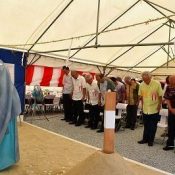
October 11, 2017 Ryukyu Shimpo
The Ryukyu Kaiun Kaisha Nakagusuku Logistics Center held a ground-breaking ceremony on October 11 at the Okinawa International Logistics Hub area in Katsuren, Uruma City.
The company’s president, Shigeru Miyagi, as well as the vice governor Moritake Tomikawa attended the ceremony with 20 other attendees. The logistics center will handle pick-up services as well as distribution, with RKK serving as a “comprehensive logistics system.” The construction of the facility is expected to be completed by Novermber 2018 and will be the largest of its kind in the prefecture with a total area of 17000 square meters. The operation will start in December.
President Miyagi made a speech, remarking; “this will be the newest facility and will meet the large demand for distribution services in Okinawa.”
The total area of the two-story facilty will be 17649 square meters. There will be automatic storage for both room-temperature and frozen products on the first floor, and the site will also have a new machine that sorts goods automatically. The machine will deliver the products from the storage to the entrance and then to the room-temperature storage room located next door. The automatic freezer will be 679 square meters and will be the biggest freezer-facility in the prefecture. The operation will be carried out by Ryukai Logistics, one of the affiliated firms of the RKK.
(English translation by T&CT and Sayaka Sakuma)
Go to Japanese








 Webcam(Kokusai Street)
Webcam(Kokusai Street)


